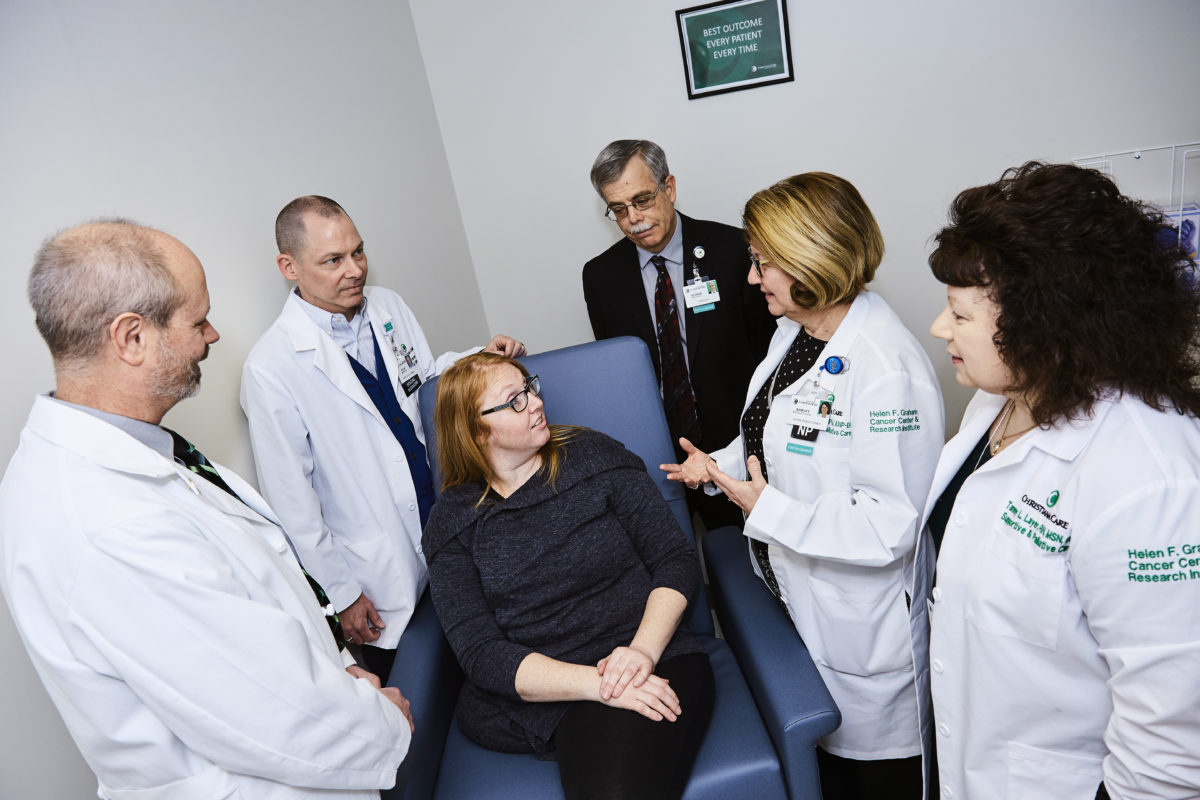Their procedure is noninvasive. It requires no technology, and it can be performed in any setting.
To a palliative care provider, this is no riddle: Their procedure is conversation.
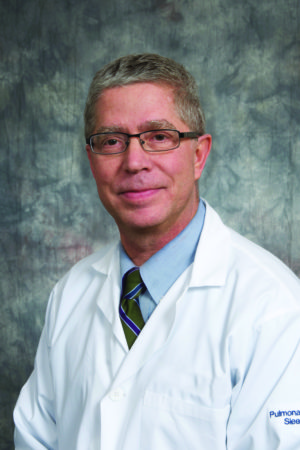
“As palliative medicine specialists, our procedure is the family meeting,” said John J. Goodill, M.D., FACP, FCCP, chief of Christiana Care’s Hospice and Palliative Medicine section. At its heart, palliative care is about skilled communication among team members, patients and families, he said. The palliative care team’s advance practice providers, including nurse practitioners and physician assistants, help deliver most inpatient palliative care consults. For patients with serious illness, they provide care that aligns with their priorities and improves their quality of life.
The team uses honest conversations to build relationships and trust, so that patients are comfortable sharing their values and goals. Palliative care complements curative treatment at any stage, and patients who are exposed to it earlier benefit the most by using their priorities to chart the road ahead.
Shirley Brogley, ACHPN, ANP-BC, who joined Christiana Care’s palliative care team in 2005, said the precursor to a productive conversation is symptom relief.
“You see the patient, manage their symptoms, build a rapport and ask permission to have a difficult conversation to talk about their illness with their loved ones,” Brogley said.
Creating an advance care directive to guide a patient’s long-term care is often a priority in these meetings, though the conversations that lead to this document tend to be just as important.
“It’s critical to choose a person to make decisions for the patient and to talk about the values that guide them,” she said.
To understand how palliative care works in practice, consider a patient with advanced-stage chronic obstructive pulmonary disease, or COPD, who has been hospitalized before. A palliative care provider will likely discuss the risks and benefits of aggressive treatment options, including a ventilator. Managing distressing symptoms such as shortness of breath and fatigue is also a priority of palliative medicine.

“Our conversations focus on what the patient considers important, as it relates to their quality of life and their own beliefs and values,” said Vinay Maheshwari, M.D., MHCDS, FCCP, vice chair of the Department of Medicine. “We deliver patient-centered care that meets their goals, which at times leads to less aggressive but more supportive care.”
Ensuring patients understand the possible results of their treatment choices is key. In the COPD example, it’s not enough to simply ask if a patient wants a tracheostomy (the insertion of a breathing tube through the windpipe) without ensuring they fully understand the potential consequences.
No matter the patient’s choice, a palliative care team can communicate this care plan to the primary team in a way that focuses everyone on the patient’s perspective, goals and needs.
Helping more patients and families
The inpatient palliative care consult service started small in 2004, with two part-time providers, before growing into an interdisciplinary team that’s on pace to provide more than 3,000 consults in 2017. Meanwhile, the service’s educational outreach has spread the practices and principles of palliative care throughout the health system.

“Our goal is that all clinicians can provide a generalist’s level of care to our patients,” said Roshni T. Guerry, M.D., inpatient medical director and a Value Institute scholar.
In 2012, Christiana Care began offering palliative care services to infants with potentially life-limiting illness and their families through the IMPACT program. Its all-volunteer team celebrates new life with families while all too often bearing witness to its loss.
Then, in 2016, Christiana Care expanded its palliative care practice to the Helen F. Graham Cancer Center & Research Institute, where it can reach nearly 1,000 patients with advanced cancer.
Now, the health system is extending palliative care services to the outpatient treatment of serious non-cancer illness, such as heart failure.
New Christiana Care data are backing up palliative care as a systemwide priority.
Dr. Maheshwari said 7-, 30- and 90-day readmission rates were significantly lower in patients who had a palliative care consult compared with those who did not.
Though palliative care is most often associated with older adults, it can complement treatment of serious illness at any age. It affirms the centrality of a patient’s quality of life — no matter how long the life lasts.
In short, Christiana Care’s growing use of palliative care is helping to deliver better care and a better experience for patients and families while lowering health care costs. And while nationally there is a shortage of palliative care physicians, Christiana Care is growing this important workforce through a shared fellowship program with the Nemours/Alfred I. duPont Hospital for Children that trains two physicians a year.
Choosing to remember
Thanks to advancements in imaging and diagnostic tools, obstetricians have become better equipped to diagnose genetic abnormalities, birth defects and other life-limiting conditions for infants. Dealing with the trauma these conditions inflict on families, though, requires a different set of skills.
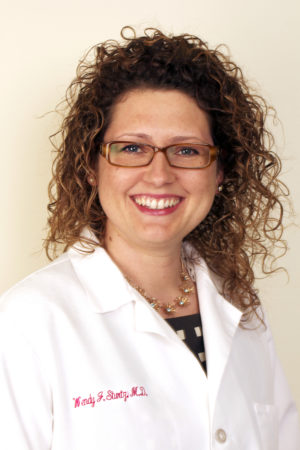
Historically, American doctors might advise pregnant women in these circumstances to terminate the pregnancy, said Wendy Sturtz, M.D., an attending neonatologist. But some families who choose to continue the pregnancy and allow their baby to die naturally, supported by a perinatal palliative care approach, may lessen the anxiety, depression and trauma of losing an infant.
In 2009, Dr. Sturtz helped form a six-person multidisciplinary team to improve the way Christiana Care takes care of families and infants in life-threatening situations, including extreme prematurity.
In 2012, her team started IMPACT, the Infant Maternal Pediatric Advanced Care Team, to provide consultative patient care, staff support and education. They now help to provide care for about 40 babies and their families a year, either prenatally (after a fetal diagnosis) or in the neonatal intensive care unit.
Even if their child will survive outside the womb for only minutes or hours, parents want to show affection and form loving memories with their baby.
“They know time with their baby is short,” said Dr. Sturtz, the team’s medical director. “They look for a connection to their baby, and we help them show their babies love and make memories.”
Sometimes, families want to take pictures with their baby and experience normal parenting activities such as dressing and putting on diapers. Part of the team’s role is to help parents honor their child and their relationship.
How that looks in practice, including the decision on whether to continue with a pregnancy, is, of course, up to the family.
“All we do is offer a suggestion,” she said. The team explains what other families have looked back on fondly and asks if these steps feel right.
The IMPACT team members also have been educating their fellow providers about how to communicate with families in these situations.
Ideally, providers can validate and reassure parents — “It is clear how much you love her” — while acknowledging their grief.
Often, perinatal palliative care is about allowing parents to grieve without trying to find a silver lining. In some cases, they don’t have to say anything; just being present is enough.
“Sometimes, the best thing we can do is to bear witness to what a family is going through,” she said.
It can be difficult to quantify the value of their work, but the team knows they make a difference when they read the poignant thank-you letters from former patients. Mixtures of grief and gratitude, these letters are reminders that parents cherish the opportunity to have shown love to their child, even briefly.
“These families have to learn how to say hello and goodbye at the same time,” Dr. Sturtz said.
Palliative care supports patients whose lives are disrupted by cancer
A cancer patient isn’t only coping with cancer; the illness brings a host of physical, emotional and practical complications. An oncologist may prescribe chemotherapy to control a tumor; the palliative medicine team can help with everything else.
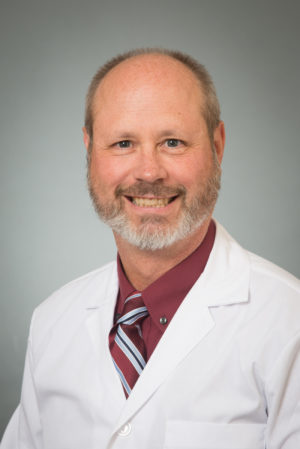
The work takes time. Kenneth Trzepkowski, M.D., medical director of the Graham Cancer Center’s Supportive and Palliative Care Team, who joined Christiana Care in 2016 after a 32-year career as a military physician, said the team may spend 90 minutes getting to know patients and their families at an initial meeting.
Michelle Bailiff, LCSW, OSW-C, oncology social work supervisor at the Graham Cancer Center, said the 2016 expansion of palliative care to the center allows providers to devote more time to symptom management.
“Patients who see our palliative providers are getting in front of a multidisciplinary team faster,” Bailiff said, including psychologists, dietitians and social workers. Social workers counsel patients through grief and gradual loss, medical and otherwise. Bailiff said patients often have what’s called “disenfranchised grief” — the losses that cancer inflicts but are unacknowledged by friends and family.
Patients may lose a job or see their close relationships changed.
“But the people around them are often focused on not losing their loved one, which makes it harder to see and acknowledge the pieces of the patient’s life that have already been taken,” Bailiff said. “Palliative care provides a place for that person to talk about what’s been lost along the way and how much it hurts.”
Palliative care beyond the hospital
In recent years, Christiana Care has accelerated its educational efforts to move palliative care beyond the hospital and outpatient Graham Cancer Center.

Christiana Care is now spreading palliative care to non-cancer outpatient settings, including through the Community-based Supportive and Palliative Care team. Linsey D. O’Donnell, DO, is the medical director of this program, which uses strategic partnerships with The Medical Group and other Christiana Care outpatient services to help patients gain access to expert palliative care.
In the Heart Failure Program, for example, that often means helping the growing number of heart attack survivors to maximize their quality of life, said Sourin Banerji, M.D., medical director of Advanced Heart Failure and Mechanical Circulatory Support.
While Dr. Banerji is focusing on stabilizing his patients’ health, the palliative care team is helping patients identify their care goals and uncovering potential roadblocks to their quality of life and develop an advanced care plan.
In order to offer palliative care services to those who can benefit most, Christiana Care is developing a predictive tool to determine which heart failure patients face the highest risk for progression.
Christiana Care is now spreading palliative care to non-cancer outpatient settings, including through the use of strategic partnerships with the ambulatory care practices at Wilmington Hospital and the Geriatrics Consult Program.
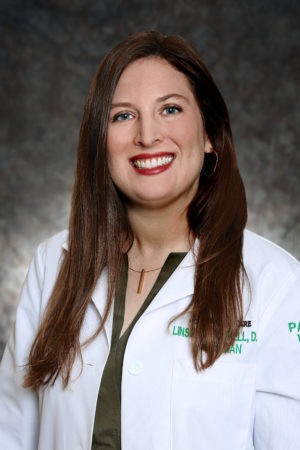
“The program has also partnered closely with CareVio and Christiana Care’s Visiting Nurse Association so palliative care can be extended to those patients,” Dr. Maheshwari said. “Our strategy is to expand, both to cancer and community-based programs, as we meet the needs of an aging community with an increasing burden of chronic disease.”
For Dr. Guerry, the heart of palliative care is aligning the patient’s experience with their goals and values.
“We want to have these conversations in the community, where patients want to have them, before a crisis occurs,” she said.
